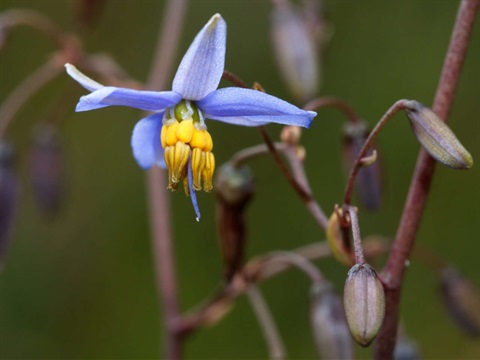
Dianella callicarpa
Swamp Flax-lily
Densely tufted perennial spreading from short underground stems.
Additional information
- SynonymSeparated from Dianella tasmanica
- FamilyAsphodelaceae (syn. Hemerocallidaceae, Liliaceae, Phormiaceae)
- StoreyLower storey
- Size0.3-1.6 m x 1.5 m
- Plant groupingLilies & Irises
- LeavesThin, mid to dark green glossy strap leaves 0.3-1.6 m x 8-20 mm, arching downwards. Leaf sheath closely folded and fused. Minutely saw-toothed on margins and midrib on lower surface, especially towards tip.
- Flower colourBluish-violet, maroon on the back. Anthers lemon, swollen stamen stalk orange.
- Flowering timeAugust to February
- FlowersNodding flowers on widely spreading flowerheads to 50 cm long, petals bent back to stem. Berries large, lumpy, glossy purple.
- Bird attractingBerries
- Butterfly attractingNo
- Frog habitatNo
- Growing conditionsMoist to wet soils in damp forests of Dandenong Ranges. Dappled shade.
- Garden usePlant under trees in moist to wet gardens. Can be grown with ferns. Use as an alternative to Agapanthus in sheltered positions.
- Commercially availableNever
- Conservation statusRare in Victoria with few known populations. Within the Shire known from one area in the Dandenongs.
- Aboriginal Use Leaves - basket making, plaiting into cords
- Related speciesDistinguish from D. tasmanica by narrower leaves, less than 2 cm, anther is longer than swollen stalk, flower head is more open and berry is lumpy rather than smooth.
Photo Gallery
Photographer/s: 1, 3 Neville Walsh, Royal Botanic Gardens Board ©; 2 Lorraine Phelan, NatureShare ©
Plant Communities